
Veesler lab
@veeslerlab.bsky.social
Pathogen entry into cells, host immune responses & vaccine design: structural biology, protein design, virology & immunology @hhmi.bsky.social
@uofwa.bsky.social
@uofwa.bsky.social
Reposted by Veesler lab
Since early 2024 we have been working with @brukercorporation.bsky.social on the first prototype timsOmni instrument, integrating an Omnitrap into a timsTOF. Here we report for the first time on the use of this instrument for protein-centric antibody sequencing. See www.biorxiv.org/content/10.1...

October 31, 2025 at 7:07 PM
Since early 2024 we have been working with @brukercorporation.bsky.social on the first prototype timsOmni instrument, integrating an Omnitrap into a timsTOF. Here we report for the first time on the use of this instrument for protein-centric antibody sequencing. See www.biorxiv.org/content/10.1...
Reposted by Veesler lab
Mysteries of trafficking of the vRNP segmented genome and assembly of influenza A virus revealed by in situ cryo-ET!
🔗 rdcu.be/eMmct
We are very excited that our paper is finally out!
🎉 Big congratulations to Moritz Wachsmuth-Melm and to everyone involved.
🔗 rdcu.be/eMmct
We are very excited that our paper is finally out!
🎉 Big congratulations to Moritz Wachsmuth-Melm and to everyone involved.

October 24, 2025 at 8:11 AM
Mysteries of trafficking of the vRNP segmented genome and assembly of influenza A virus revealed by in situ cryo-ET!
🔗 rdcu.be/eMmct
We are very excited that our paper is finally out!
🎉 Big congratulations to Moritz Wachsmuth-Melm and to everyone involved.
🔗 rdcu.be/eMmct
We are very excited that our paper is finally out!
🎉 Big congratulations to Moritz Wachsmuth-Melm and to everyone involved.
Our latest work on #COVID immunity and imprinting in humans.
Led by Ale Tortorici and Kaiti Sprouse with @aminaddetia.bsky.social and several others!
www.biorxiv.org/content/10.1...
Led by Ale Tortorici and Kaiti Sprouse with @aminaddetia.bsky.social and several others!
www.biorxiv.org/content/10.1...

Repeated COVID-19 vaccine boosters elicit variant-specific memory B cells in humans
The first exposure to a pathogen or an antigen profoundly impacts immune responses upon subsequent encounter with related pathogens. This immune imprinting explains that infection or vaccination with ...
www.biorxiv.org
October 21, 2025 at 3:42 AM
Our latest work on #COVID immunity and imprinting in humans.
Led by Ale Tortorici and Kaiti Sprouse with @aminaddetia.bsky.social and several others!
www.biorxiv.org/content/10.1...
Led by Ale Tortorici and Kaiti Sprouse with @aminaddetia.bsky.social and several others!
www.biorxiv.org/content/10.1...
Reposted by Veesler lab
Now out in Science! Cyclin-dependent kinases (CDKs) are key regulators of the cell cycle. In @vcushing.bsky.social's magnum opus, we use #cryoEM to figure out how the CDK-activating kinase recognises CDKs to fully activate them - a key step in cell cycle control.
www.science.org/doi/10.1126/...
www.science.org/doi/10.1126/...

Structural basis of T-loop–independent recognition and activation of CDKs by the CDK-activating kinase
Cyclin-dependent kinases (CDKs) are prototypical regulators of the cell cycle. The CDK-activating kinase (CAK) acts as a master regulator of CDK activity by catalyzing the activating phosphorylation o...
www.science.org
October 16, 2025 at 7:17 PM
Now out in Science! Cyclin-dependent kinases (CDKs) are key regulators of the cell cycle. In @vcushing.bsky.social's magnum opus, we use #cryoEM to figure out how the CDK-activating kinase recognises CDKs to fully activate them - a key step in cell cycle control.
www.science.org/doi/10.1126/...
www.science.org/doi/10.1126/...
Reposted by Veesler lab
Exciting to see our protein binder design pipeline BindCraft published in its final form in @Nature ! This has been an amazing collaborative effort with Lennart, Christian, @sokrypton.org, Bruno and many other amazing lab members and collaborators.
www.nature.com/articles/s41...
www.nature.com/articles/s41...
August 27, 2025 at 4:14 PM
Exciting to see our protein binder design pipeline BindCraft published in its final form in @Nature ! This has been an amazing collaborative effort with Lennart, Christian, @sokrypton.org, Bruno and many other amazing lab members and collaborators.
www.nature.com/articles/s41...
www.nature.com/articles/s41...
Reposted by Veesler lab
I am excited to share our latest preprint presenting the structure of human NHE6, a key endosomal Na⁺/H⁺ exchanger involved in Christianson syndrome.
We bring together #cryo-EM, NMR, SAXS, lipidomics, and functional assays for an integrative analysis of NHE6 architecture, function, and regulation.
We bring together #cryo-EM, NMR, SAXS, lipidomics, and functional assays for an integrative analysis of NHE6 architecture, function, and regulation.
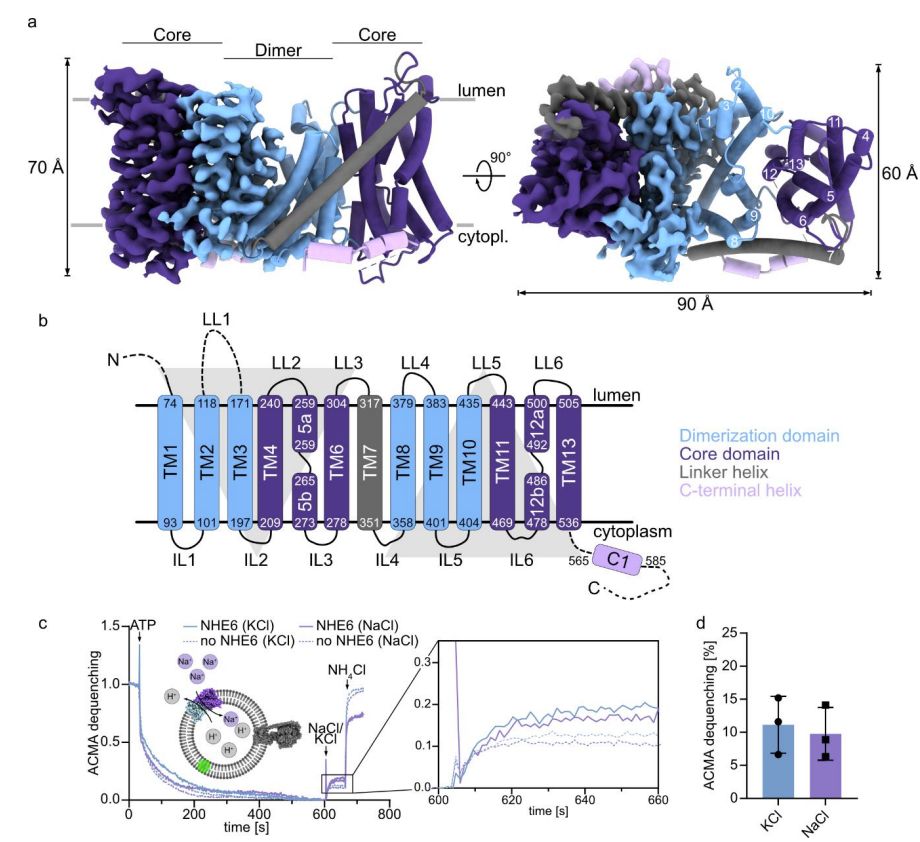
July 28, 2025 at 9:31 PM
I am excited to share our latest preprint presenting the structure of human NHE6, a key endosomal Na⁺/H⁺ exchanger involved in Christianson syndrome.
We bring together #cryo-EM, NMR, SAXS, lipidomics, and functional assays for an integrative analysis of NHE6 architecture, function, and regulation.
We bring together #cryo-EM, NMR, SAXS, lipidomics, and functional assays for an integrative analysis of NHE6 architecture, function, and regulation.
Reposted by Veesler lab
We sequenced the anti-RSV-F antibody 131-2a by mass spec and determined its epitope by cryoEM. New insights in postfusion specific binding and antigenic site I. Now published in ACS Infectious Diseases @pubs.acs.org.
pubs.acs.org/doi/10.1021/...
@xdh.bsky.social @hangryhobbit.bsky.social
pubs.acs.org/doi/10.1021/...
@xdh.bsky.social @hangryhobbit.bsky.social

July 22, 2025 at 11:33 AM
We sequenced the anti-RSV-F antibody 131-2a by mass spec and determined its epitope by cryoEM. New insights in postfusion specific binding and antigenic site I. Now published in ACS Infectious Diseases @pubs.acs.org.
pubs.acs.org/doi/10.1021/...
@xdh.bsky.social @hangryhobbit.bsky.social
pubs.acs.org/doi/10.1021/...
@xdh.bsky.social @hangryhobbit.bsky.social
Reposted by Veesler lab
Our entrance into protein design! Inverse folding steered by external sources of information, and for multiple conformations. By the amazing @kaiyi94.bsky.social and @kjamali.bsky.social!
Download our code and try it yourself. 🥳
Download our code and try it yourself. 🥳
Excited to share our paper at #ICML: All-atom inverse protein folding through discrete flow matching with @kjamali.bsky.social and @sjorsscheres.bsky.social : openreview.net/forum?id=8tQdw…. If you are at ICML, let’s connect and talk generative models&protein design!
OpenReview
Promoting openness in scientific communication and the peer-review process
https://openreview.net/forum?id=8tQdw…
July 15, 2025 at 7:18 AM
Our entrance into protein design! Inverse folding steered by external sources of information, and for multiple conformations. By the amazing @kaiyi94.bsky.social and @kjamali.bsky.social!
Download our code and try it yourself. 🥳
Download our code and try it yourself. 🥳
Reposted by Veesler lab
Important insights into FCoV-23 cell entry from the @veeslerlab.bsky.social
Freely available: www.nature.com/articles/s41...
Freely available: www.nature.com/articles/s41...
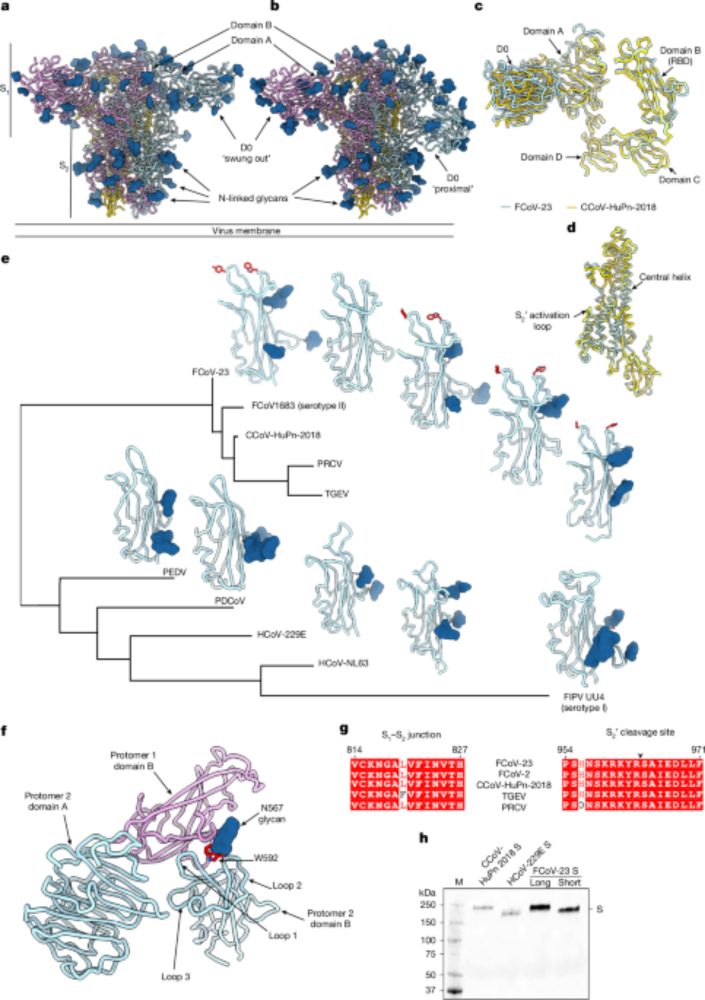
Loss of FCoV-23 spike domain 0 enhances fusogenicity and entry kinetics - Nature
The molecular mechanisms of cell entry for the recently identified highly pathogenic feline coronavirus FCoV-23 are characterized in detail.
www.nature.com
July 11, 2025 at 1:48 PM
Important insights into FCoV-23 cell entry from the @veeslerlab.bsky.social
Freely available: www.nature.com/articles/s41...
Freely available: www.nature.com/articles/s41...
Reposted by Veesler lab
Loss of FCoV-23 spike domain 0 enhances fusogenicity and entry kinetics pubmed.ncbi.nlm.nih.gov/40634609/ #cryoem
July 11, 2025 at 2:43 AM
Loss of FCoV-23 spike domain 0 enhances fusogenicity and entry kinetics pubmed.ncbi.nlm.nih.gov/40634609/ #cryoem
Our paper describing how in-host evolution of a recently emerged, highly pathogenic coronavirus modulates entry into cells, membrane fusion and likely pathogenicity has now been published in its peer-reviewed form!
Led by Ale Tortorici!
@hhmi.org
www.nature.com/articles/s41...
Led by Ale Tortorici!
@hhmi.org
www.nature.com/articles/s41...
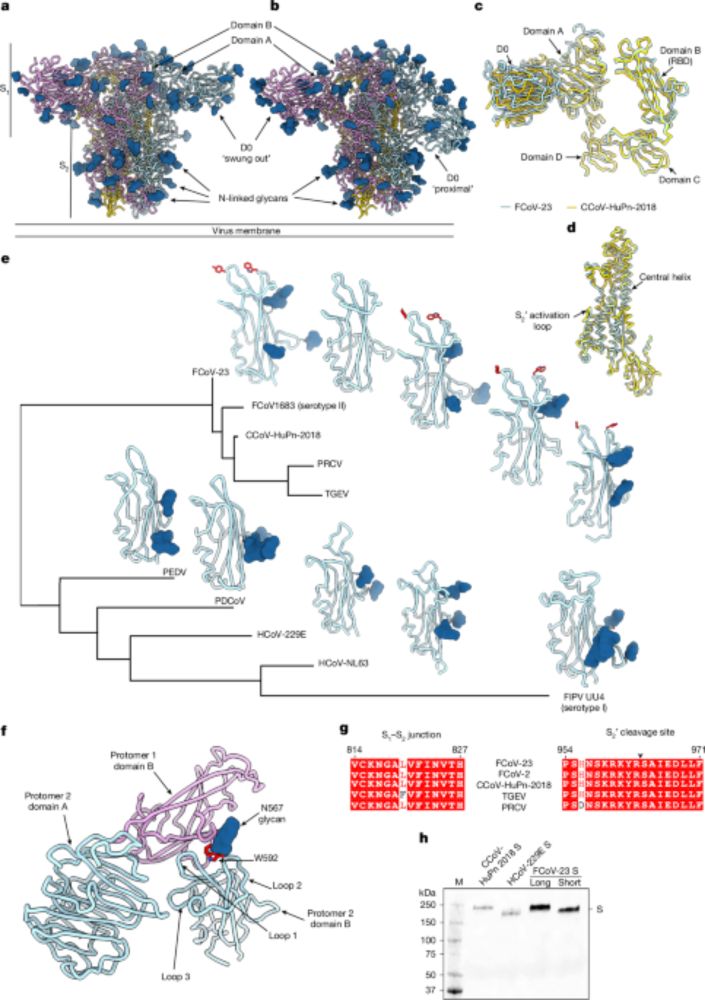
Loss of FCoV-23 spike domain 0 enhances fusogenicity and entry kinetics - Nature
The molecular mechanisms of cell entry for the recently identified highly pathogenic feline coronavirus FCoV-23 are characterized in detail.
www.nature.com
July 9, 2025 at 4:25 PM
Our paper describing how in-host evolution of a recently emerged, highly pathogenic coronavirus modulates entry into cells, membrane fusion and likely pathogenicity has now been published in its peer-reviewed form!
Led by Ale Tortorici!
@hhmi.org
www.nature.com/articles/s41...
Led by Ale Tortorici!
@hhmi.org
www.nature.com/articles/s41...
Reposted by Veesler lab
Our effort to try to do something for [cystic fibrosis (CF)] started as a basic science enterprise. That was a hard slog back in the 1980s. Nobody would have supported except NIH. Now, 30 years after that discovery, young people with CF get to plan for retirement instead of an early funeral.
![A lot of what NIH funds is basic science, which focuses on discoveries that might or might not result in practical applications. How can you describe the value of basic science to the public? To most people, it seems nebulous. It might take 30 years of research to pay off in a practical way.
Yes, it’s hard for people to understand the importance of basic science. I think the best way to deal with that is to talk about examples.
I’ll reflect on my experience with cystic fibrosis research. The effort to try to do something for that almost-uniformly fatal disease started as a basic science enterprise to try to discover the nature of the gene that is misspelled. That was a hard slog back in the 1980s. Nobody would have supported [research into it] except NIH.
That work by my University of Michigan lab, working with Lap-Chee Tsui at the Hospital for Sick Kids in Toronto, led to the discovery of the gene [and the mutation that causes the disease] in 1989. Then, a partnership of NIH-funded research, philanthropy from the Cystic Fibrosis Foundation, and investments by biotech and pharma led to a therapeutic breakthrough.
Now, 30 years after the gene discovery, young people with cystic fibrosis are planning for retirement instead of an early funeral.](https://cdn.bsky.app/img/feed_thumbnail/plain/did:plc:7e6gdj33irtt6i7vc6hozfah/bafkreic6ydv2aqftxi3caocigytazotzicudx4uww37l2acn3misi6dkka@jpeg)
June 21, 2025 at 3:29 AM
Our effort to try to do something for [cystic fibrosis (CF)] started as a basic science enterprise. That was a hard slog back in the 1980s. Nobody would have supported except NIH. Now, 30 years after that discovery, young people with CF get to plan for retirement instead of an early funeral.
Reposted by Veesler lab
Congratulations @stanford-chemh.bsky.social Institute Scholar @cobarnes27.bsky.social on being named a 2025 Freeman Hrabowski Scholar @hhmi.org 🎉 🍾
www.hhmi.org/programs/fre...
www.hhmi.org/programs/fre...

The 2025 Freeman Hrabowski Scholars | HHMI
Freeman Hrabowski Scholars are outstanding early career faculty who have the potential to become leaders in their research fields.
www.hhmi.org
June 19, 2025 at 6:03 AM
Congratulations @stanford-chemh.bsky.social Institute Scholar @cobarnes27.bsky.social on being named a 2025 Freeman Hrabowski Scholar @hhmi.org 🎉 🍾
www.hhmi.org/programs/fre...
www.hhmi.org/programs/fre...
Reposted by Veesler lab
I have exhorted others to share positive news even in these uncertain times for US science.
I am really excited that @tamanash.bsky.social’s first paper on the remarkable evolutionary gymnastics of dual-host viruses (even in single codons) is now online.
Follow along here 🧪🧵
I am really excited that @tamanash.bsky.social’s first paper on the remarkable evolutionary gymnastics of dual-host viruses (even in single codons) is now online.
Follow along here 🧪🧵
Our study exploring the evolutionary mechanism of alphavirus opal codon retention is now online! www.science.org/doi/10.1126/...
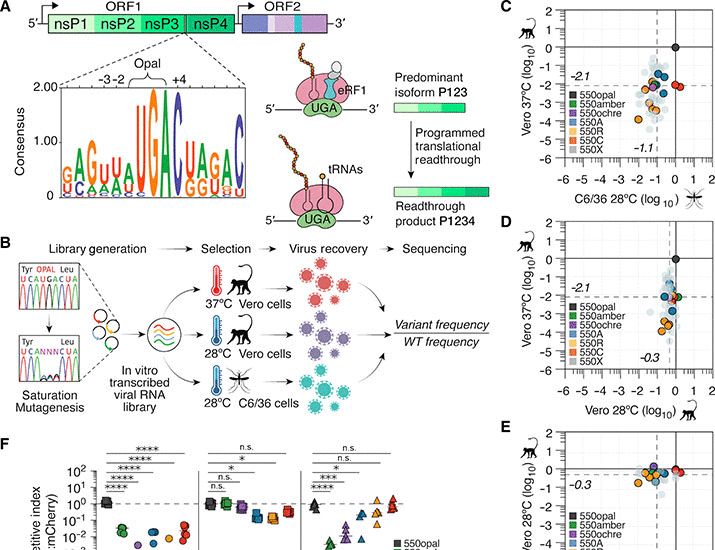
A conserved opal termination codon optimizes a temperature-dependent trade-off between protein production and processing in alphaviruses
Alphaviruses optimize viral polymerase production and polyprotein processing at distinct temperatures via a premature stop codon.
www.science.org
April 18, 2025 at 11:11 PM
I have exhorted others to share positive news even in these uncertain times for US science.
I am really excited that @tamanash.bsky.social’s first paper on the remarkable evolutionary gymnastics of dual-host viruses (even in single codons) is now online.
Follow along here 🧪🧵
I am really excited that @tamanash.bsky.social’s first paper on the remarkable evolutionary gymnastics of dual-host viruses (even in single codons) is now online.
Follow along here 🧪🧵
Outbreaks of Marburg virus (MARV) disease have been increasingly more frequent recently. Here we describe a prefusion-stabilized MARV GP and a best-in-class MARV neutralizing antibody!
Led by @aminaddetia.bsky.social with @virbiotechnology.bsky.social
@hhmi.org
www.biorxiv.org/content/10.1...
Led by @aminaddetia.bsky.social with @virbiotechnology.bsky.social
@hhmi.org
www.biorxiv.org/content/10.1...

Potent neutralization of Marburg virus by a vaccine-elicited monoclonal antibody
Marburg virus (MARV) is a filovirus that causes a severe and often lethal hemorrhagic fever. Despite the increasing frequency of MARV outbreaks, no vaccines or therapeutics are licensed for use in hum...
www.biorxiv.org
May 18, 2025 at 8:40 PM
Outbreaks of Marburg virus (MARV) disease have been increasingly more frequent recently. Here we describe a prefusion-stabilized MARV GP and a best-in-class MARV neutralizing antibody!
Led by @aminaddetia.bsky.social with @virbiotechnology.bsky.social
@hhmi.org
www.biorxiv.org/content/10.1...
Led by @aminaddetia.bsky.social with @virbiotechnology.bsky.social
@hhmi.org
www.biorxiv.org/content/10.1...
Delighted to share our most recent work on designing broadly protective sarbecovirus vaccines and defining the path forward for other coronaviruses.
Led by @aminaddetia.bsky.social
@hhmi.org
www.biorxiv.org/content/10.1...
Led by @aminaddetia.bsky.social
@hhmi.org
www.biorxiv.org/content/10.1...

Phylogeny-driven design of broadly protective sarbecovirus receptor-binding domain nanoparticle vaccines
Vaccines against emerging SARS-CoV-2 variants and sarbecoviruses with pandemic potential must elicit a robust humoral immune response in a population imprinted with the SARS-CoV-2 spike (S) protein. H...
www.biorxiv.org
May 14, 2025 at 2:21 PM
Delighted to share our most recent work on designing broadly protective sarbecovirus vaccines and defining the path forward for other coronaviruses.
Led by @aminaddetia.bsky.social
@hhmi.org
www.biorxiv.org/content/10.1...
Led by @aminaddetia.bsky.social
@hhmi.org
www.biorxiv.org/content/10.1...
Reposted by Veesler lab
Phylogeny-driven design of broadly protective sarbecovirus receptor-binding domain nanoparticle vaccines https://www.biorxiv.org/content/10.1101/2025.05.11.652904v1
May 14, 2025 at 3:16 AM
Phylogeny-driven design of broadly protective sarbecovirus receptor-binding domain nanoparticle vaccines https://www.biorxiv.org/content/10.1101/2025.05.11.652904v1
Reposted by Veesler lab
Simultaneous polyclonal antibody sequencing and epitope mapping by cryoEM and mass spec: how far can we go? Check out the final version of our paper in eLife:
elifesciences.org/articles/101...
elifesciences.org/articles/101...


April 29, 2025 at 9:18 AM
Simultaneous polyclonal antibody sequencing and epitope mapping by cryoEM and mass spec: how far can we go? Check out the final version of our paper in eLife:
elifesciences.org/articles/101...
elifesciences.org/articles/101...
Reposted by Veesler lab
Excited to be giving this webinar soon. Hope to see you then!
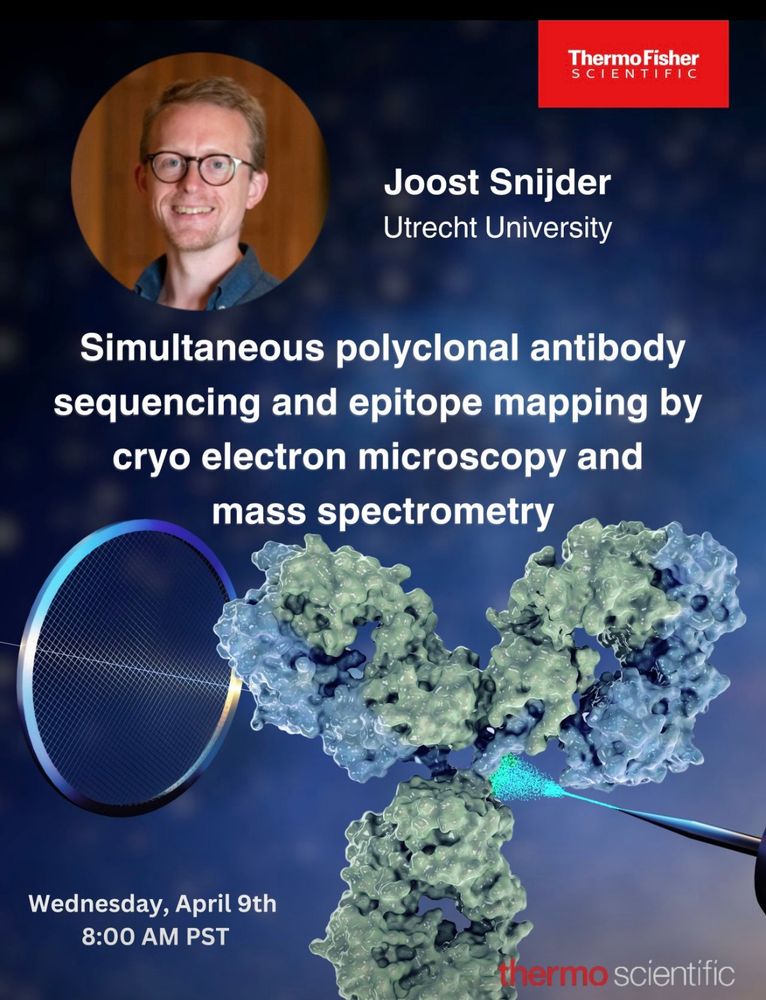
March 14, 2025 at 6:49 AM
Excited to be giving this webinar soon. Hope to see you then!
Reposted by Veesler lab
Congrats to Jeremy Hollis on receiving the Weintraub Award! A well-deserved recognition to a person who exemplifies (and resembles?) Hal.


March 4, 2025 at 7:44 PM
Congrats to Jeremy Hollis on receiving the Weintraub Award! A well-deserved recognition to a person who exemplifies (and resembles?) Hal.
Reposted by Veesler lab
#NIHFundedDiscovery
How do cells avoid the "kiss of death"?
Gap junctions share life-saving signals—but under stress, they shut down to prevent spreading cytotoxic damage.
#CryoEM reveals the molecular switches behind this process!
www.biorxiv.org/content/10.1...
www.biorxiv.org/content/10.1...
How do cells avoid the "kiss of death"?
Gap junctions share life-saving signals—but under stress, they shut down to prevent spreading cytotoxic damage.
#CryoEM reveals the molecular switches behind this process!
www.biorxiv.org/content/10.1...
www.biorxiv.org/content/10.1...
February 21, 2025 at 11:27 PM
#NIHFundedDiscovery
How do cells avoid the "kiss of death"?
Gap junctions share life-saving signals—but under stress, they shut down to prevent spreading cytotoxic damage.
#CryoEM reveals the molecular switches behind this process!
www.biorxiv.org/content/10.1...
www.biorxiv.org/content/10.1...
How do cells avoid the "kiss of death"?
Gap junctions share life-saving signals—but under stress, they shut down to prevent spreading cytotoxic damage.
#CryoEM reveals the molecular switches behind this process!
www.biorxiv.org/content/10.1...
www.biorxiv.org/content/10.1...
We show that the HKU25 clade of merbecoviruses utilizes the ACE2 receptor with a binding mode sharing similarity to HKU5, suggesting a common evolutionary origin of ACE2 utilization.
Led by Young-Jun Park on our side.
Collab with Huan Yan's lab!
@hhmi.bsky.social
www.biorxiv.org/content/10.1...
Led by Young-Jun Park on our side.
Collab with Huan Yan's lab!
@hhmi.bsky.social
www.biorxiv.org/content/10.1...

ACE2 utilization of HKU25 clade MERS-related coronaviruses with broad geographic distribution
Dipeptidyl peptidase-4 (DPP4) is a well-established receptor for several MERS-related coronaviruses (MERSr-CoVs) isolated from humans, camels, pangolins, and bats. However, the receptor usage of many ...
www.biorxiv.org
February 21, 2025 at 2:12 AM
We show that the HKU25 clade of merbecoviruses utilizes the ACE2 receptor with a binding mode sharing similarity to HKU5, suggesting a common evolutionary origin of ACE2 utilization.
Led by Young-Jun Park on our side.
Collab with Huan Yan's lab!
@hhmi.bsky.social
www.biorxiv.org/content/10.1...
Led by Young-Jun Park on our side.
Collab with Huan Yan's lab!
@hhmi.bsky.social
www.biorxiv.org/content/10.1...
Reposted by Veesler lab
We trained a genomic language model on all observed evolution, which we are calling Evo 2.
The model achieves an unprecedented breadth in capabilities, enabling prediction and design tasks from molecular to genome scale and across all three domains of life.
The model achieves an unprecedented breadth in capabilities, enabling prediction and design tasks from molecular to genome scale and across all three domains of life.

February 19, 2025 at 4:42 PM
We trained a genomic language model on all observed evolution, which we are calling Evo 2.
The model achieves an unprecedented breadth in capabilities, enabling prediction and design tasks from molecular to genome scale and across all three domains of life.
The model achieves an unprecedented breadth in capabilities, enabling prediction and design tasks from molecular to genome scale and across all three domains of life.
In these 2 papers, we show that two merbecovirus clades (HKU5 & MOW15-22, distantly related to MERS-CoV) independently evolved ACE2 receptor utilization, reshaping our understanding of coronavirus evolution
Led by Young-Jun Park on our side!
@hhmi.bsky.social
www.cell.com/cell/fulltex...
Led by Young-Jun Park on our side!
@hhmi.bsky.social
www.cell.com/cell/fulltex...

Molecular basis of convergent evolution of ACE2 receptor utilization among HKU5 coronaviruses
The family of coronaviruses known as merbecoviruses has generally been thought to
use the host cell protein DPP4 for entry, but this study shows that the merbecovirus
HKU5 can enter host cells of the ...
www.cell.com
February 7, 2025 at 4:12 PM
In these 2 papers, we show that two merbecovirus clades (HKU5 & MOW15-22, distantly related to MERS-CoV) independently evolved ACE2 receptor utilization, reshaping our understanding of coronavirus evolution
Led by Young-Jun Park on our side!
@hhmi.bsky.social
www.cell.com/cell/fulltex...
Led by Young-Jun Park on our side!
@hhmi.bsky.social
www.cell.com/cell/fulltex...
Reposted by Veesler lab
Calling all structural enthusiasts! An accurate depiction of the structure of DNA in #Lego is under 2000 supporters away from being considered to become a real set!
It even has Franklin, Watson, and Crick minifigures and a Lego photgraph 51 and Bragg's law!
ideas.lego.com/projects/c92...
It even has Franklin, Watson, and Crick minifigures and a Lego photgraph 51 and Bragg's law!
ideas.lego.com/projects/c92...

Lego DNA 2.0: Double Helix History
Step into the extraordinary world of Lego DNA 2.0: Double Helix History, a celebration of the 70th anniversary of the landmark DNA structure ...
ideas.lego.com
January 17, 2025 at 2:08 PM
Calling all structural enthusiasts! An accurate depiction of the structure of DNA in #Lego is under 2000 supporters away from being considered to become a real set!
It even has Franklin, Watson, and Crick minifigures and a Lego photgraph 51 and Bragg's law!
ideas.lego.com/projects/c92...
It even has Franklin, Watson, and Crick minifigures and a Lego photgraph 51 and Bragg's law!
ideas.lego.com/projects/c92...

